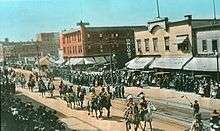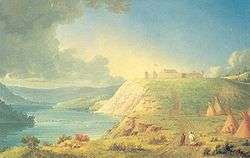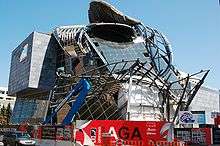History of Edmonton
The first inhabitants settled in the area that is now Edmonton, Alberta, Canada around 3,000 BC and perhaps as early as 10,000 BC, when an ice-free corridor opened up as the last ice age ended and timber, water, and wildlife became available in the region.[1]

Early history
Edmonton, like many places in North America, had been inhabited for thousands of years by First Nations groups.
Fur trade

In 1795, European traders of the North West Company (NWC) established Fort Augustus north of Edmonton.[2] The Hudson's Bay Company (HBC), a competitor with the North West Company in the North American fur trade, built Edmonton House (later Fort Edmonton) adjacent to Fort Augustus a year later.[3][2]
In 1802, both forts were moved 30 kilometres (19 mi) south to the Rossdale Flats, south of present-day downtown Edmonton.[2] The forts were briefly moved 80 kilometres (50 mi) north, before they moved back to the Rossdale Flats site in 1813.[2] Following the merger of the HBC and NWC in 1821, the name Fort Augustus was dropped, with operations centralized under Fort Edmonton.[2] The fort served as headquarters for the HBC fur trade operations North Saskatchewan District of Rupert's Land.[2] The Rossdale location remained in use until 1830, when flooding forced the construction of a new Fort Edmonton on higher ground. The area presently occupied by the Alberta Legislature Building was selected as the site for the new Fort Edmonton.[2] The decline of the fur trade in the 1860s led to the abandonment of several buildings at Fort Edmonton in the following decades.[4] The fort was eventually dismantled in 1915.
Early settlement (1870–1945)
The first settlement outside of the fort was in the 1870s, pioneer farmers living in rustic log cabins along the river - these farms formed the structure for the 1882 survey of the land into "River lots". "1885 Street" at Fort Edmonton Park represents the early hamlet of Edmonton. The Town of Edmonton was established in 1894. The town encompassed modern Boyle Street (the original downtown) and McCauley neighbourhoods.

In 1870, the Hudson's Bay Company had been granted a reserve on much of the present downtown, but by 1913, the peak of the World War I land price inflationary boom, it was all sold off. Edmonton got its first railway in 1903 when a branch-line from Calgary via southside Strathcona was built to cross the Low Level Bridge. Edmonton became a city in 1904 and shortly after, with a mere 5,000 people became Alberta's capital. With the new land west of Queens Avenue (modern 100 St) available to the city, the city grew tremendously, and Boyle Street was abandoned as the downtown for the new, current downtown. Many new communities like Glenora, Highlands, and Westmount were built in this time as the economy started to gain momentum. And during the early 1910s, Edmonton grew very rapidly, causing rising speculation in real estate prices. In 1912, Edmonton amalgamated with the city of Strathcona, south of the North Saskatchewan River; as a result, the city extended south of the river.[5]
Just prior to World War I, the real estate boom ended suddenly, causing the city's population to decline sharply—from over 72,500 in 1914 to under 54,000 only two years later.[6] The high rate of volunteer enlistment to the army during the war contributed to the drop in population. The city slowly grew in population and economy during the 1920s and 1930s, until taking off during and after World War II.
The first licensed airfield in Canada, Blatchford Field (now Edmonton City Centre (Blatchford Field) Airport), commenced operation in 1929.[7] Pioneering aviators such as Wilfrid R. "Wop" May and Max Ward used Blatchford Field as a major base for the distribution of mail, food, and medicine to Northern Canada; hence Edmonton's role as the "Gateway to the North" was strengthened. During World War II saw Edmonton's becoming a major base for the construction of the Alaska Highway and the Northwest Staging Route.[8]
Post World War II history
Oil boom (1947–1989)

The first major oil discovery in Alberta was made on February 13, 1947, near the town of Leduc, south of Edmonton.[9] As early as 1914, oil reserves were known to exist in the southern parts of Alberta (see Turner Valley, Alberta), but they produced very little oil compared to those around Edmonton. Additional oil reserves were discovered in the late 1940s and the 1950s near the town of Redwater. Because most of Alberta's oil reserves were concentrated in central and northern Alberta, Edmonton became home to most of Alberta's oil industry.
The subsequent oil boom gave Edmonton new status as the "Oil Capital of Canada," and during the 1950s, the city increased in population from 149,000 to 269,000.[6] After a relatively calm but still prosperous period in the 1960s, the city's growth took on renewed vigour concomitant with high world oil prices, triggered by the 1973 oil crisis and the 1979 Iranian Revolution. The oil boom of the 1970s and 1980s ended abruptly with the sharp decline in oil prices on the international market and the introduction of the National Energy Program in 1981; that same year, the population had reached 521,000.[6] Although the National Energy Program was later scrapped by the federal government in the mid-1980s, the collapse of world oil prices in 1986 and massive government cutbacks kept the city from making a full economic recovery until the late 1990s.[10]
In 1981, West Edmonton Mall, the world's largest at the time, opened.[11] Still the biggest in North America, the mall is one of Alberta's most-visited tourist attractions, and contains an indoor amusement park, a large indoor waterpark, a skating rink, a full size replica of the Santa Maria, a dining and bar district, and a luxury hotel, in addition to over 700 shops and services.[12][13] On June 14, 1986, when Galaxyland's Mindbender derailed and slammed into a post, three people died and the fourth was injured.
On July 31, 1987, a devastating tornado (ranked F4 on the Fujita scale; main article: Edmonton tornado) hit the city and killed 27 people.[14] The storm hit the areas of Beaumont, Mill Woods, Bannerman, Fraser, and Evergreen.[15] The day became known as "Black Friday."[16] Then-mayor Laurence Decore cited the community's response to the tornado as evidence that Edmonton was a "city of champions," which popularized the city's unofficial slogan originally coined in 1984 to promote Edmonton.[17] It was further popularized in a sporting context later in 1987 upon the Edmonton Eskimos winning the Grey Cup after the Edmonton Oilers won the Stanley Cup earlier in the year.[17]
Recent history (1990 to present)
The city entered a recent period of economic recovery and prosperity in the late 1990s, aided by a strong recovery in oil prices and further economic diversification.[18] While oil production and refining remains the basis of many jobs in Edmonton, the city's economy has managed to diversify significantly (e.g., an explosion in high-tech jobs).[19] Downtown Edmonton and parts of the inner city, after years of extremely high office vacancy rates and neglect, have recovered to a great degree, with office vacancy rates in downtown Edmonton at 5.0%.[20] The downtown area is still undergoing a renaissance of its own, with further new projects underway or about to become reality and more people choosing to live in or near the downtown core (although suburban sprawl is still growing significantly).[21]

In recent years, downtown Edmonton has seen rapid development, with streets like Jasper Avenue and 104 Street featuring many clubs, shops, restaurants, and galleries. Much of this growth has been spurred in the last 2 years by the completion of the downtown arena.[22] The new Art Gallery of Alberta opened in the downtown core in January 2010.[23] The first new office tower in 22 years, the EPCOR Tower, began construction in 2008 and was completed in July 2010.[24] The Icon Towers, completed in 2010, were the tallest residential buildings in the city, being surpassed by The Pearl (Edmonton) in 2015.[25] while many other high-rise condos are still under construction in the downtown core. Due to demand of density outside the core, three neighbourhoods (two just outside downtown)—Century Park, Glenora, and Strathearn—have proposed new high-rise urban villages, several of which are currently under construction.[26]
Also in the outskirts, new residential areas are under development, such as Big Lake, Ellerslie, The Grange, Heritage Valley, Lewis Farms, The Meadows, The Palisades, Pilot Sound, and Windermere[27] among others, as well as new power centres such as those within The Meadows[28] and Windermere.[29]
This economic prosperity is bringing in large numbers of workers from all over Canada. It was forecasted that 83,000 new residents would move to Edmonton between 2006 and 2010, twice the rate that city planners had expected.[30] Many of the new workers moving to the city are young men.[31]
In 2008, the Edmonton metropolitan area surpassed one million becoming the most northern city in North America with a metropolitan population over one million.[32] In 2016 new Rogers Place arena opened as part of downtown Ice District. In 2016 the final Northeast leg of the Anthony Henday Drive (HWY 216) is completed. Edmonton is the first city in Canada to have 100% free-flowing highway ring road. In 2018, construction of the Stantec Tower is completed, becoming the tallest building in Canada outside of Toronto
References
- Jim Willet. "Edmonton River Valley". Edmonton River Valley. Retrieved 2009-02-27.
- "HBC Heritage - Edmonton". hbcheritage.ca. Hudson's Bay Company. 2019. Retrieved 11 June 2019.
- Edmonton Local. "How Did Edmonton City Get Its Name?". Retrieved 2011-09-12.
- ""Is this the original fort?"". Fort Edmonton Park. 13 September 2013. Retrieved 11 June 2019.
- City of Edmonton. "Ward System (1970 - present)". City of Edmonton. Retrieved 2009-03-23.
- City of Edmonton. "Population, Historical" (PDF). City of Edmonton. Archived from the original (PDF) on 2006-03-04. Retrieved 2007-02-26.
- Edmonton Airports. "Historical". Archived from the original on 2009-05-05. Retrieved 2009-02-27.
- Canadian Geographical Journal. "Historical". Archived from the original on 2010-09-05. Retrieved 2009-03-01. Cite journal requires
|journal=(help) - Government of Canada. "Historical". Archived from the original on 2009-02-16. Retrieved 2009-02-27.
- Edmonton Public Library. "Chapter 7. Riding the Roller Coaster, 1973-2004". Archived from the original on 2007-06-25. Retrieved 2009-02-27.
- West Edmonton Mall. "Shopping in West Edmonton Mall". West Edmonton Mall. Retrieved 2009-02-27.
- West Edmonton Mall. "EDMONTON". Retrieved 2009-03-06.
- Fowlow, Loraine Dearstyne. "West Edmonton Mall". The Canadian Encyclopedia. Rev. by Geoffrey Simmins. Historica-Dominion. Retrieved June 2, 2012.
- Canadian Broadcasting Corporation. "Edmonton Tornado". CBC News. Retrieved 2009-02-27.
- Environment Canada. "A map of the city of Edmonton showing the path of the tornado". Archived from the original on 2009-03-19. Retrieved 2009-03-23.
- Reed Timmer. "20th Anniversary of "Black Friday"—The Edmonton, AB F4 Tornado". TornadoVideos.net. Archived from the original on 2008-02-04. Retrieved 2009-03-06.
- "Economic Development Edmonton 'Branding Edmonton' Initiative" (Doc). City of Edmonton. March 28, 2003. Retrieved April 29, 2017.
The use of the slogan in Edmonton dates back to 1984, when Councillor Cavanagh and Leo Leclerc coined it as a way to promote Edmonton. Its use was popularized in 1987, when Mayor Lawrence Decore used it to describe Edmonton’s response to the tornado. Edmonton Sun columnist Terry Jones also used it in 1987, when the Edmonton Eskimos and Edmonton Oilers both won championships. The City never officially sanctioned the slogan.
- Alberta's Real Estate History. "Recovery". Real Estate Heritage. Retrieved 2009-03-06.
- Edmonton Journal. "RecoveryTiny devices turn into big profits for Edmonton high-tech firm" (PDF). Edmonton Journal. Archived from the original (PDF) on 2009-03-19. Retrieved 2009-03-06.
- Realty Advisors. "Sublet Vacancy in Canada's Office Markets" (PDF). Realty Advisors. Archived from the original (PDF) on 2009-03-19. Retrieved 2009-03-06.
- Capital City Downtown. "Downtown" (PDF). City of Edmonton. Retrieved 2009-02-27.
- Todd Babiak. "Jasper Avenue on a warm summer day". Edmonton Journal. Archived from the original on 2013-01-18. Retrieved 2009-03-06.
- "New Alberta art gallery unveiled". CBC News. January 31, 2010. Retrieved April 25, 2012.
- Edmonton Journal. "New Epcor tower to rise on former station site". Archived from the original on 2012-03-14. Retrieved 2009-03-06.
- City Scape. "Icon Towers". Archived from the original on 2006-05-07. Retrieved 2009-03-06.
- Jeff Kenworthy. "Urban Villages". Murdoch University. Archived from the original on 2009-09-15. Retrieved 2009-03-06.
- "Welcome to Edmonton Maps". City of Edmonton. Archived from the original on 2006-09-02. Retrieved 2009-06-03.
- Collier International. "The Meadows Power Center" (PDF). Retrieved 2009-03-06.
- Collier International. "Windermere Power Center" (PDF). Retrieved 2009-03-06.
- Canadian Press (2006-11-20). "Demographics blamed for Edmonton's murder surge". CTV News. Archived from the original on 2007-10-12. Retrieved 2007-10-27.
- Statistics Canada (2006-07-20). "The Daily, Thursday, July 20, 2006". Government of Canada. Archived from the original on October 16, 2007. Retrieved 2007-10-27.
- "History of Edmonton". City of Edmonton. Retrieved 14 March 2010.